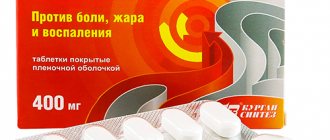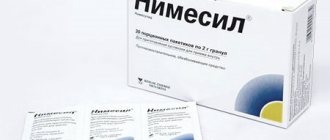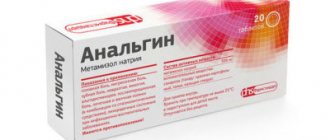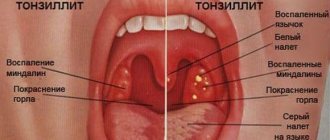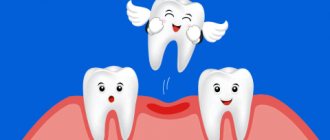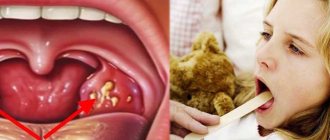Side effects
When using the drug, the following side effects are rarely possible:
From the gastrointestinal tract: nausea, vomiting, discomfort or pain in the epigastrium, laxative effect, the occurrence of erosive and ulcerative lesions, bleeding.
From the nervous system: headache, dizziness, psychomotor agitation, insomnia.
From the hematopoietic organs: anemia, thrombocytopenia, agranulocytosis, leukopenia.
From the urinary system: impaired renal function, cystitis.
Allergic reactions: skin rash, itching, urticaria, exacerbation of bronchial asthma, angioedema, anaphylactoid reactions, anaphylactic shock, bronchospasm, fever, erythema multiforme exudative (including Stevens-Johnson syndrome), toxic epidermal necrolysis (Lyell's syndrome).
From the cardiovascular system: tachycardia, increased blood pressure.
The child complains of pain in the upper abdomen.
Peptic ulcer of the stomach and duodenum is an inflammatory disease that occurs with ulcerations of the mucous membrane of the stomach and duodenum. The causes and predisposing factors are the same as for gastritis.
With gastritis and peptic ulcers, gastroesophageal reflux often occurs - acidic gastric juice enters the esophagus, which is manifested by belching, pain in the stomach after eating, and heartburn.
With peptic ulcers, these symptoms are more pronounced.
Directions for use and doses
Rectally. The dosage for children depends on the age and body weight of the child.
Post-immunization fever: children under 1 year - 1 supp., over 1 year, if necessary, 1 more supp. in 6 hours
Fever and pain
Single dose - 5-10 mg/kg body weight 3-4 times a day. The maximum daily dose is no more than 30 mg/kg/day.
Children aged 3–9 months (5.5–8.0 kg) - 1 supp. (60 mg) 3 times within 24 hours every 6–8 hours, not more than 180 mg/day; from 9 months to 2 years (8.0–12.5 kg) - 1 sup. (60 mg) 4 times within 24 hours every 6 hours, but not more than 240 mg/day.
Duration of treatment: as an antipyretic - no more than 3 days; as a pain reliever - no more than 5 days.
If fever persists, you should consult your doctor.
How to take Nurofen?
Nurofen must be used exactly as indicated in the instructions for the drug or as prescribed by your doctor. Do not take more than recommended dosage or exceed the recommended duration of use. Always take only the minimum effective dosage.
The maximum dosage of Nurofen for adults is 800 mg at a time or 3200 mg per day (4 maximum doses). Use only the minimum amount needed to relieve pain, inflammation or fever.
The dosage of Nurofen for a child depends on his age and weight. Therefore, taking the drug for children is possible only as prescribed by a doctor.
In order to protect the stomach from the irritating effects of Nurofen, you can combine taking the drug with food or milk.
If you purchased the medicine in suspension form, shake the bottle thoroughly before measuring the dose using a measuring spoon or syringe.
Be careful!
If you take Nurofen for a long time, you must undergo regular tests and a medical examination.
The medicine should be stored at room temperature away from moisture, heat and sunlight. The drug in the form of a suspension cannot be frozen.
Before use, be sure to read the instructions and consult your doctor.
Buy Nurofen for children film-coated tablets 200 mg No. 8 in pharmacies
Instructions for use Nurofen Buy at the pharmacy Nurofen for children tablet p.o 200 mg No. 8 Dosage forms tablets 200 mg Synonyms Ibuprofen Ibufen Nurofen for children Group Anti-inflammatory drugs - derivatives of propionic acid International nonproprietary name Ibuprofen Composition Active substance: ibuprofen. Manufacturers Reckitt Benckiser Healthcare International Ltd (Great Britain) Pharmacological action Anti-inflammatory, analgesic, antipyretic. Non-selectively inhibits two isoenzymes of cyclooxygenase. The maximum concentration is created after 0.5-1 hour. Slowly penetrates into the joint cavity, but lingers in the synovial tissue, creating higher concentrations in it than in plasma. Subject to biotransformation. Excreted by the kidneys. The anti-inflammatory effect is associated with a decrease in vascular permeability, improvement of microcirculation, decreased release of inflammatory mediators from cells and suppression of energy supply to the inflammatory process. The analgesic effect is due to a decrease in the intensity of inflammation, a decrease in the production of bradykinin and its algogenicity. A decrease in the excitability of the heat-regulating centers of the diencephalon results in an antipyretic effect. With a single dose, the effect lasts up to 8 hours. It has an antipyretic effect, the severity of which depends on the initial body temperature and dose. Reversibly inhibits platelet aggregation. Side effects : Dyspeptic disorders (nausea, heartburn, anorexia, vomiting, discomfort in the epigastric region, flatulence, diarrhea, constipation), erosive and ulcerative lesions of the gastrointestinal tract with signs of gastrointestinal bleeding, headache, dizziness, tinnitus, insomnia, agitation, visual disturbances (blurred vision, changes in color vision), fluid retention, edema, increased blood pressure, thrombocytopenia, granulocytopenia, hemolytic anemia, Quincke's edema, broncho-obstructive syndrome, allergic skin reactions. Indications for use : Rheumatoid arthritis, reactive synovitis in osteoarthritis deformans, psoriatic arthritis, acute joint attack in gout, ankylosing spondylitis (Bechterew's disease), cervical spondylosis, Barre-Lieu syndrome (cervical migraine, vertebral artery syndrome), lumbodynia, sciatica, thoracic radicular syndrome, bursitis, tenosynovitis, myalgia, neuralgic amyotrophy, occipital and intercostal neuralgia, ligament sprains, hematomas, trauma, pain in the surgical wound area, toothache, oral surgery, panniculitis, tonsillitis, pharyngitis, laryngitis, sinusitis, rhinitis , bronchitis, pneumonia, inflammatory processes in the pelvis, dysalgomenorrhea, colds, ARVI, febrile states, postural hypotension when taking antihypertensive drugs, nephrotic syndrome (to reduce the severity of proteinuria).
Dosage regimen
The drug is prescribed to adults and children over 12 years of age orally, after meals, in tablets of 200 mg 3-4 times a day. The tablets should be taken with water. To achieve a rapid therapeutic effect in adults, the dose can be increased to 400 mg (2 tablets) 3 times a day. Children from 6 to 12 years old: 1 tablet no more than 4 times a day; the drug can only be used if the child weighs more than 20 kg. The interval between taking tablets is at least six hours. Do not take more than 6 tablets in 24 hours. The maximum daily dose is 1200 mg. If symptoms persist after taking the drug for 2-3 days, you should stop treatment and consult a doctor.
Contraindications Hypersensitivity, peptic ulcer of the stomach and duodenum in the acute phase, nonspecific ulcerative colitis, aspirin-induced asthma, leukopenia, thrombocytopenia, hemorrhagic diathesis, severe dysfunction of the liver and kidneys, portal hypertension, arterial hypertension, heart failure, diseases of the optic nerve, scotoma , amblyopia, color vision impairment, pregnancy, breastfeeding. Overdose Symptoms: abdominal pain, nausea, vomiting, lethargy, drowsiness, depression, headache, tinnitus, metabolic acidosis, coma, acute renal failure, hypotension, bradycardia, tachycardia, atrial fibrillation and respiratory arrest. Treatment: gastric lavage (only during the first hour after administration), activated charcoal (to reduce absorption), alkaline drinking, forced diuresis and symptomatic therapy (correction of acid-base status, blood pressure, gastrointestinal bleeding). Interaction Reduces the antihypertensive activity of ACE inhibitors, the natriuretic activity of furosemide and hypothiazide. May increase the toxicity of methotrexate and lithium preparations. When combined with coumarin-type anticoagulants and alcohol, it increases the risk of hemorrhagic complications, and with tableted glucocorticoids - the risk of gastrointestinal bleeding. It is not recommended to use simultaneously with acetylsalicylic acid or other NSAIDs, antidiabetic drugs, phenytoin and hormonal contraceptives. Increases the concentration of digoxin in plasma. Caffeine enhances the analgesic effect of ibuprofen. Special instructions Considering the possibility of developing NSAID gastropathy, it is prescribed with caution to elderly people with a history of stomach ulcers and other gastrointestinal diseases, gastrointestinal bleeding, with simultaneous therapy with glucocorticoids, other NSAIDs and for long-term therapy. When symptoms of gastropathy appear, careful monitoring is indicated (including esophagogastroduodenoscopy, blood test to determine hemoglobin, hematocrit, stool test for occult blood). To prevent the development of NSAID gastropathy, it is recommended to combine it with PGE drugs (misoprostol). Prescribed with caution in children (up to 12 years), patients with severely impaired liver and kidney function (regular monitoring of bilirubin levels, transaminases, creatinine, renal concentrating ability is required), arterial hypertension and chronic heart failure (daily monitoring of diuresis, body weight , blood pressure). If visual impairment occurs, the dose should be reduced or the drug discontinued. It is not recommended to consume alcoholic beverages during treatment. Storage conditions List B. In a place protected from light at room temperature.
Overdose of Nurofen™ for children, symptoms and treatment
Increasing the dose to 400 mg/kg may cause acute intoxication, which may be accompanied by nausea, vomiting, abdominal pain, dizziness, headache, drowsiness, nystagmus, blurred vision, tinnitus and, rarely, decreased blood pressure, metabolic acidosis, and renal failure. and loss of consciousness. When the first signs of overdose appear, you should immediately stop using the drug and carry out symptomatic therapy. There is no specific antidote.
Interactions of Nurofen™ for children
Concomitant use with:
- acetylsalicylic acid or with other NSAIDs and GCS drugs (the risk of side effects from the gastrointestinal tract increases);
- anticoagulants (increasing the effect of oral anticoagulants and increasing the risk of bleeding).
Use cautiously simultaneously with:
- antihypertensive drugs and diuretics (increased risk of developing a reaction from the kidneys);
- methotrexate and lithium drugs (increased levels of these drugs in the blood plasma);
- cyclosporines (drug interactions are possible, which can lead to an increased risk of nephrotoxicity).
Special instructions for the use of Nurofen™ for children
The drug should be used with caution when:
- systemic connective tissue diseases;
- hypertension (arterial hypertension) and/or heart disease;
- liver and/or kidney failure.
If gastrointestinal bleeding or ulcers develop, the drug should be discontinued immediately. In patients with severe dehydration, ensure sufficient fluid intake. Particular caution must be exercised when used in children with severe dehydration due to diarrhea, after major surgical interventions, with cardiac, hepatic and renal failure, when using diuretics. In these cases, careful monitoring of diuresis and renal function is necessary.


